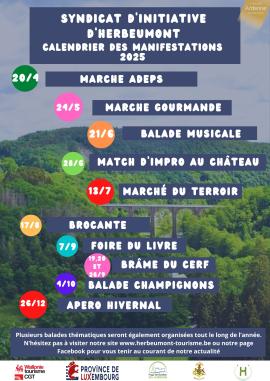The villages of the Herbeumont municipality
Herbeumont
The name Herbeumont can be explained by dividing it into two separate words. "Herb" is the German word for "rough", the second word "Mont" is derived from the Latin for "height".
On the other hand the name can also be understood as "Mountain of grass"
Herbeumont is a very old village indeed; but did it already exist in the Roman era? Although there is no proof, people assume so because there is a roman road, located at a place called "Poteau Straimont" near the idyllic river l'Antrogne, crossing the Herbeumont forests.
The Abbot Tillière, author of the history of Orval, confirms that in the VII-th century, the domain of the priory "Les Conques", nowadays a hotel and restaurant, already existed. It is also assumed that at the time of Charlemagne, there were glassworks active near to the first bridge at the Antrogne. First written records date from 1192 (Archives Administration Wallonia territory). We know that the castle was built in 1268. For several centuries, the village life went along with that of the fortress.
Much later, mining activities converted Herbeumont into a flourishing industrial area. Shale expoitation and manufacturing of slates made Herbeumont famous throughout Belgium and far beyond. Also the cultivation of tobacco made the village well known.
Saint-Médard-Gribomont
The origin of Saint-Médard goes back to the year 941. The village was then part of Chiny County.
During a hunt, the daughter of the lord was missing and the search remained fruitless. After praying Saint-Médard, she was found dead at the foot of an oak where, loyal to his promise, the lord built a chapel in honor of the saint.
Some cottages came to join.
In this way the village of Saint-Médard was born.The chapel that can be seen today was built in 1857 and restored in 1985. The stained glass windows tell the regional history.
Martilly
Like Saint-Médard and other villages in the municipality, Martilly was part of the Chiny County in the Middle Ages. At that time, the small township was the seat of a "High Court". A gallows was installed there, above the village, at a place called "The Dead Man". From there (nowadays!),a beautiful view opens to the Vierre meanders. In the 60s up to the 80s, Martilly was well known as a craft village.
Straimont
Straimont village is located on the National Highway 85 "Neufchâteau - Florenville."
At Straimont, anglers will find a peaceful haven to practice their favorite sport. For lovers of swimming, a lake was built on Vierre.
The name comes from the Latin Strata Straimont = "paved road, main road." Indeed, the route of Antonin (geographical route constructed around 280) reports that the Roman road Reims - Arlon - Trier was passing by this place.
In 2004, Réserves Naturelles - Natagora was starting a new project in the old town Straimont: the creation of a nature reservation area of 16.50 ares in the Vierre Valley. Being a typical crystal transparent Ardennes river, the Vierre is well known to naturalists, walkers and nature lovers in general. Being a major tributary of the Semois that it is joining up in Jamoigne, the river is characterized by a rich meandering course passing sometimes through wet meadows, sometimes through hardwood and spruce. The landscape interest of the place is truly remarkable. In spring, the river is also embellished with many white blooms of aquatic buttercups. The river is the kingdom of kingfishers and dippers, not hesitating to immerse themselves in search of food on the Vierre river bed. In addition to several ever fascinating species of raptors, two emblematic birds can be seen in and around the forest environments: the black stork and raven. The large wading bird is well known for his spontaneous return in our regions while the first free reproduction of the raven, reintroduced in Belgium, happened in Straimont. Among various birds of passage, we also report the marsh warbler, grasshopper warbler, the pied flycatcher, the nightingale, wood warbler, bullfinch and snipe in the winter.
Menugoutte
The pretty township of Menugoutte consists of a few farms and a dozen houses. It was in its time(XIII-XIX century) the obligatory crossing point for laborers walking from Neufchâteau and surroundings to the forges of Waillimont.
It is said that Menugoutte got its name from rest stops made by the workers who - often after a hard day – used to drink a"small drop" (menue goutte).




